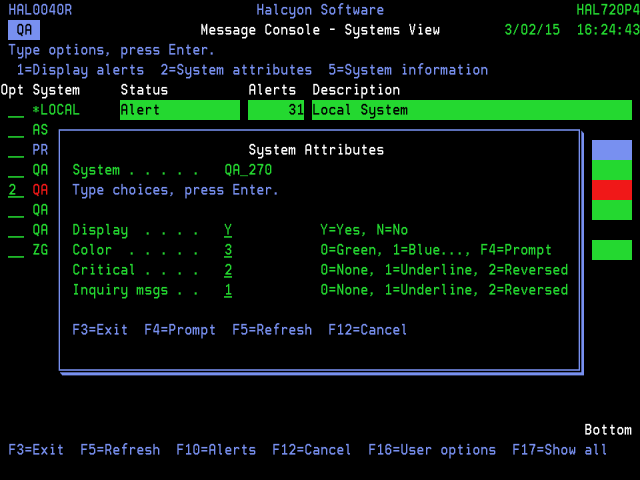Message Console - Systems view
The Message Console - Systems view lists the systems that are defined in Work with Remote Locations and indicates the status of each system. This shows at-a-glance whether any alerts are pending for each system.
To switch to the Consoles view, use F10=Consoles to display all virtual consoles on this system. Press F10 again to switch to the Alerts view alerts or use option 1=Display Alerts to display only the alerts for the selected system.

Parameters on the Message Console - Systems View display
The following parameters are shown on the Message Console - Systems View display.
System
Displays the name of the systems as defined in Work with Remote Locations. *LOCAL indicates the local system.
Status
Displays the current system status.
| OK | Indicates that there are no alerts for this system |
| Alert | Indicates that there are alerts pending for this system |
| Omit | Indicates that this system is omitted from the Systems view except when F17=Show All is pressed |
| System Error | Indicates that at least one of the Primary Action Monitor, Network Send Monitor and Receive Monitor are not running on the local system. This may prevent alerts from being received or responses sent. This status applies to *LOCAL system only |
| Network Error | Indicates that the local system is not able to communicate with this system. Alerts cannot be received from this system. You are unable to respond to existing alerts |
Description
This displays the textual description of the system.
Using the Message Console - Systems view
The following options are available when working with the Message Console - Systems view. Type the option number in the Opt column against the required selection.
Display alerts
Use option 1=Display alerts to switch to the Message Console Alerts view, subsetted on the selected system.
System attributes
Use option 2=System attributes to open the System Attributes window that allows you to specify how information for the selected system is displayed.

Display
Specifies whether the selected system is shown on the Message Console - Systems View display.
| Y | This system is shown on the Message Console - Systems View display |
| N | This system is not shown on the Message Console - Systems View display unless F17=Show All is used. Any alerts received from this system are still shown on the Message Console - Alerts View display |
Color
Specifies the color to be used for this system. The system is shown in the chosen color on the Systems view and alerts from the System are displayed in the chosen color on the Alerts view.
| 0 | Green |
| 1 | Blue |
| 2 | White |
| 3 | Red |
| 4 | Turquoise |
| 5 | Yellow |
| 6 | Pink |
Critical
Specifies the messages view display attribute to use for critical alerts when generated from this system. By default, critical alerts are message alerts where the message severity is 50 or greater, but this can be overridden when a ‘Console’ action is defined.
| 0 | Normal text |
| 1 | Underlined text |
| 2 | Reverse image text |
Inquiry messages
Specifies the messages view display attribute to use for inquiry messages generated from this system.
| 0 | Normal text |
| 1 | Underlined text |
| 2 | Reverse image text |
System information
Use option 5=System information to open the Display System Information window that displays system and product information from the selected system.
The following functions are available when working with the Message Console - Systems view:
F3=Exit
Use F3=Exit to close the current display and return to the main menu.
F5=Refresh
Use F5=Refresh to refresh the display with current information.
F10=Alerts
Use F10=Alerts to switch the Console view from Systems to Alerts.
F12=Cancel
Use F12=Cancel to close and current display and return to the previous display.
F16=User options
Use F16=User options to open the User Options display which allows user preferences to be set.
F17=Show all
Use F17=Show all to include systems that were omitted using the Console Attributes window. You can then use option 2=Console attributes to re-include a system if required.
Clearing Message Console Messages
It is possible to clear the Message Console of all messages by using the Clear Message Console (CLRMSGCON) command.